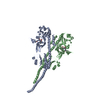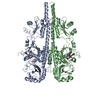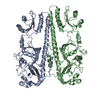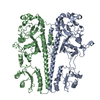[English] 日本語
 Yorodumi
Yorodumi- PDB-8uqi: Pr/Pfr heterodimeric state of photosensory core module of Stigmat... -
+ Open data
Open data
- Basic information
Basic information
| Entry | Database: PDB / ID: 8uqi | |||||||||
|---|---|---|---|---|---|---|---|---|---|---|
| Title | Pr/Pfr heterodimeric state of photosensory core module of Stigmatella aurantiaca bacteriophytochrome 2 | |||||||||
 Components Components | Bacteriophytochrome (Light-regulated signal transduction histidine kinase) | |||||||||
 Keywords Keywords | SIGNALING PROTEIN / Red light photoreceptor / two component system | |||||||||
| Function / homology |  Function and homology information Function and homology informationosmosensory signaling via phosphorelay pathway / detection of visible light / phosphorelay response regulator activity / histidine kinase / phosphorelay sensor kinase activity / protein kinase activator activity / photoreceptor activity / regulation of DNA-templated transcription Similarity search - Function | |||||||||
| Biological species |  Stigmatella aurantiaca (bacteria) Stigmatella aurantiaca (bacteria) | |||||||||
| Method | ELECTRON MICROSCOPY / single particle reconstruction / cryo EM / Resolution: 4.5 Å | |||||||||
 Authors Authors | Malla, T.N. / Schmidt, M. / Stojkovic, E.A. | |||||||||
| Funding support |  United States, 2items United States, 2items
| |||||||||
 Citation Citation |  Journal: Sci Adv / Year: 2024 Journal: Sci Adv / Year: 2024Title: Photoreception and signaling in bacterial phytochrome revealed by single-particle cryo-EM. Authors: Tek Narsingh Malla / Carolina Hernandez / Srinivasan Muniyappan / David Menendez / Dorina Bizhga / Joshua H Mendez / Peter Schwander / Emina A Stojković / Marius Schmidt /  Abstract: Phytochromes are red-light photoreceptors discovered in plants with homologs in bacteria and fungi that regulate a variety of physiological responses. They display a reversible photocycle between two ...Phytochromes are red-light photoreceptors discovered in plants with homologs in bacteria and fungi that regulate a variety of physiological responses. They display a reversible photocycle between two distinct states: a red-light-absorbing Pr state and a far-red light-absorbing Pfr state. The photoconversion regulates the activity of an enzymatic domain, usually a histidine kinase (HK). The molecular mechanism that explains how light controls the HK activity is not understood because structures of unmodified bacterial phytochromes with HK activity are missing. Here, we report three cryo-electron microscopy structures of a wild-type bacterial phytochrome with HK activity determined as Pr and Pfr homodimers and as a Pr/Pfr heterodimer with individual subunits in distinct states. We propose that the Pr/Pfr heterodimer is a physiologically relevant signal transduction intermediate. Our results offer insight into the molecular mechanism that controls the enzymatic activity of the HK as part of a bacterial two-component system that perceives and transduces light signals. | |||||||||
| History |
|
- Structure visualization
Structure visualization
| Structure viewer | Molecule:  Molmil Molmil Jmol/JSmol Jmol/JSmol |
|---|
- Downloads & links
Downloads & links
- Download
Download
| PDBx/mmCIF format |  8uqi.cif.gz 8uqi.cif.gz | 181.9 KB | Display |  PDBx/mmCIF format PDBx/mmCIF format |
|---|---|---|---|---|
| PDB format |  pdb8uqi.ent.gz pdb8uqi.ent.gz | 137.4 KB | Display |  PDB format PDB format |
| PDBx/mmJSON format |  8uqi.json.gz 8uqi.json.gz | Tree view |  PDBx/mmJSON format PDBx/mmJSON format | |
| Others |  Other downloads Other downloads |
-Validation report
| Arichive directory |  https://data.pdbj.org/pub/pdb/validation_reports/uq/8uqi https://data.pdbj.org/pub/pdb/validation_reports/uq/8uqi ftp://data.pdbj.org/pub/pdb/validation_reports/uq/8uqi ftp://data.pdbj.org/pub/pdb/validation_reports/uq/8uqi | HTTPS FTP |
|---|
-Related structure data
| Related structure data |  42469MC  8uphC  8upkC  8upmC  8uqkC M: map data used to model this data C: citing same article ( |
|---|---|
| Similar structure data | Similarity search - Function & homology  F&H Search F&H Search |
- Links
Links
- Assembly
Assembly
| Deposited unit | 
|
|---|---|
| 1 |
|
- Components
Components
| #1: Protein | Mass: 81150.758 Da / Num. of mol.: 2 Source method: isolated from a genetically manipulated source Source: (gene. exp.)  Stigmatella aurantiaca (bacteria) / Gene: SAMN05444354_11920 / Production host: Stigmatella aurantiaca (bacteria) / Gene: SAMN05444354_11920 / Production host:  |
|---|
-Experimental details
-Experiment
| Experiment | Method: ELECTRON MICROSCOPY |
|---|---|
| EM experiment | Aggregation state: PARTICLE / 3D reconstruction method: single particle reconstruction |
- Sample preparation
Sample preparation
| Component | Name: Stigmatella aurantiaca bacteriophytochrome / Type: ORGANELLE OR CELLULAR COMPONENT / Entity ID: all / Source: RECOMBINANT |
|---|---|
| Source (natural) | Organism:  Stigmatella aurantiaca (bacteria) Stigmatella aurantiaca (bacteria) |
| Source (recombinant) | Organism:  |
| Buffer solution | pH: 8 |
| Specimen | Embedding applied: NO / Shadowing applied: NO / Staining applied: NO / Vitrification applied: YES |
| Vitrification | Cryogen name: ETHANE |
- Electron microscopy imaging
Electron microscopy imaging
| Experimental equipment |  Model: Titan Krios / Image courtesy: FEI Company |
|---|---|
| Microscopy | Model: TFS KRIOS |
| Electron gun | Electron source:  FIELD EMISSION GUN / Accelerating voltage: 300 kV / Illumination mode: FLOOD BEAM FIELD EMISSION GUN / Accelerating voltage: 300 kV / Illumination mode: FLOOD BEAM |
| Electron lens | Mode: BRIGHT FIELD / Nominal defocus max: 3100 nm / Nominal defocus min: 900 nm |
| Image recording | Electron dose: 42.11 e/Å2 / Film or detector model: GATAN K3 BIOQUANTUM (6k x 4k) |
- Processing
Processing
| EM software | Name: PHENIX / Version: 1.19.2_4158: / Category: model refinement | ||||||||||||||||||||||||
|---|---|---|---|---|---|---|---|---|---|---|---|---|---|---|---|---|---|---|---|---|---|---|---|---|---|
| CTF correction | Type: NONE | ||||||||||||||||||||||||
| 3D reconstruction | Resolution: 4.5 Å / Resolution method: FSC 0.143 CUT-OFF / Num. of particles: 301363 / Symmetry type: POINT | ||||||||||||||||||||||||
| Refinement | Cross valid method: NONE Stereochemistry target values: GeoStd + Monomer Library + CDL v1.2 | ||||||||||||||||||||||||
| Displacement parameters | Biso mean: 460.73 Å2 | ||||||||||||||||||||||||
| Refine LS restraints |
|
 Movie
Movie Controller
Controller






 PDBj
PDBj


